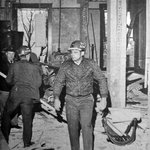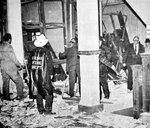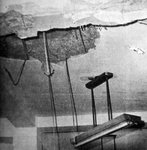By early December 1969 – exactly 10 years ago – Franklin County law enforcement authorities were still searching for clues to the identity of two submachine gun-wielding men who …
This item is available in full to subscribers.
We have recently launched a new and improved website. To continue reading, you will need to either log into your subscriber account, or purchase a new subscription.
If you are a current print subscriber, you can set up a free website account by clicking here.
Otherwise, click here to view your options for subscribing.
Please log in to continue |
|



By early December 1969 – exactly 10 years ago – Franklin County law enforcement authorities were still searching for clues to the identity of two submachine gun-wielding men who apparently detonated an explosive device in the county courthouse in Union as a diversionary tactic, and then proceeded to rob the United Bank of Union some $18,000.
The explosion literally rocked the courthouse, causing extensive strucutral damage; miraculously no one was killed. A few blocks away, the gunmen robbed the bank, eluded road blocks and escaped. Two brothers were eventually charged with the armed robbery after one of them was arrested in March 1970 in connection with a bank robbery in Danbury, Conn., that also involved diversionary explosions.
However, the episode did not end there. It was just the beginning of a saga that spanned the better part of a decade and involved two homicides, the death of one of the brothers from wounds he incurred when he attempted to break out of a Connecticut jail, another attempted jail break by the remaining brother, and the eventual dismissal of charges in the Union bombing-bank robbery case when the remaining suspect was brought back to Franklin County in January 1976 for trial. The charge was dismissed due to lack of evidence.
It all began just before 2 p.m. Thursday, Nov. 13, 1969, when the Franklin County Courthouse was jolted by an explosion on the second floor of the structure, near the sheriff's office. Two minutes later, two gunmen entered the United Bank of Union and quickly escaped with $18,000.
The bomb, thought to be a plastic explosive concealed in a brief case, had been placed under a bench near the sheriff's office. It exploded with a thunderous roar, shattering most of the second floor. One rescue worker noted that it was a miracle no one was killed. Seven persons were injured and received medical treatment, and several others received minor cuts from flying glass.
Walls on the second floor were torn down, windows were shattered and glass flew everywhere. People were buried in debris and quick action by the Union fire department and ambulance corps resulted in evacuation of the injured.
An estimated 90 percent of the windows were blown out, and the concussion from the explosion caused damage throughout the three-story structure.
The explosion tore a hold almost three feet in diameter in the thick concrete-and-steel-reinforced floor, but no one was injured in the office directly below the blast. Dust immediately filled the entire building and it was several minutes before rescue workers could make their way through debris to aid the injured.
Nearest the blast were four members of the sheriff's department, all who suffered minor injuries, and Ben Hammer, the county highway engineer, who was hospitalized with cuts and a compound fracture of his arm.
An employee in the county clerk's office was blown from one room into another, but escaped serious injury. Circuit Judge Joseph T. Tate, in his office on the third floor, was unscathed when windows shattered.
Clean-up operations began immediately after the injured were removed from the building, and by 5 p.m. – three hours after the blast – several windows on the first floor of the courthouse had been boarded shut.
Sixteen employees and five customers were in the bank just after 2 p.m. when the armed robbers rushed in and made everyone lie on the floor after firing three shots into the ceiling. Money was taken from the tellers windows, but the main vault – secured by a time lock – could not be opened.
An alarm was sounded from the bank, but it was connected to the sheriff's office, which already was in ruins and no assistance would be forthcoming from there. A deputy had managed to notify Gasconade County authorities and the State Highway Patrol at Kirkwood moments after the blast. Roadblocks were set up, but the two gunmen had simply disappeared.
And two other people, a man and his elderly mother, had also disappeared from their home near Union the day of the robbery. Authorities speculated at the time that they had possibly been taken hostage by the bank robbers.
Three months later to the day – on Feb. 13, 1970 – two gunmen detonated three explosive devices as a diversion, and escaped with $40,000 from a bank in Danbury, Conn. While no definite link between the two bank robberies was established, Federal Bureau of Investigation agents began exploring that possibility. There were some similarities.
In the Connecticut robbery, bombs were detonated at three different locations to confuse police and destroy alarm systems. The bank? The Union Savings Bank!
Twenty-five persons were injured in the blasts, and two were hospitalized. The explosions came in close sequence at the police station, the bank, and in a car at a parking lot.
Two bandits entered the bank and ordered 13 employees to lie on the floor while they emptied cash drawers. The robbers tossed a bomb into the bank's main room as they escaped, and the ensuing explosion shattered windows and caused several injuries.
Minutes later, a car reported stolen earlier from Kennedy National Airport in New York was demolished by an explosion as it sat in a parking lot.
The two gun-toting bandits escaped with their loot from the Danbury bank.
Less than a month later, the first break – and the first link to the Franklin County bombind and hold-up – came with the arrest of a Danbury man and issuance of warrants for his brother's arrest in connection with the bank robbery in Danbury.
The two were identified as John Russell Pardue, 27, who was arrested, and his brother James, of Lusby, Md., who was being sought by federal authorities, and was eventually arrested.
Back in Franklin County, a link to the episode there was also established: The Pardue brothers were the sons of John R. Pardue of Union, who together with his mother, Mrs. Daisy Pardue, were the two persons stillmissing from the Union area since the day of the bombing and bank robbery!
Six-count indictments against each of the brothers were returned by a Danbury grand jury in March 1970, and a month later a St. Louis grand jury began considering indictments against the pair in relation to the Union bombing and robberies at banks in both Union and Pacific.
The Missouri grand jury later indicted James Pardue in connection with the Union and Pacific bank robberies, but no mention was made of the courthouse bombing. By that time, John Pardue Jr. and his wife had been charged with an escape attempt from a Connecticut jail after she had attempted to smuggle a gun into her husband's cell.
By the spring of 1971, James Pardue had been declared mentally unfit to stand trial for his alleged part in the Danbury bombings and bank robbery, and John was still in a Connecticut jail.
In early April, John was shot three times during a second escape attempt, and was in critical condition in a Bridgeport, Conn., hospital. He had pulled a sawed-off rifle from concealment as he was being taken to a courtroom to stand trial on the charges. His wife was arrested nearby and charged with aiding her husband in the attempted escape.
John Pardue was then transferred to a federal hospital in Springfield, Mo., where he died April 29, 1971, from complications of the gunshot wounds suffered in the April 8 attempted jail break.
About two weeks prior to that, Connecticut authorities began to unravel more of the mystery surrounding the missing father and grandmother of the Pardue brothers.
Dental records aided in the identification of one of two bodies found in Maryland as that of John Pardue Sr. The second body was believed to be that of his mother, Daisy.
They had been missing since November 1969 shortly after Pardue's two sons had been implicated as suspects in the Franklin County Courthouse bombing and Union bank robbery.
The badly-decomposed bodies had been discovered under a two-ton slab of concrete floor in a small tool shed on a farm formerly owned by James Pardue near Lusby, Md. Authorities speculated that the two had been shot and killed in Missouri.
John Pardue was now dead, and his brother, James, was in the same federal hospital in Springfield, Mo., where John had died from his gunshot wounds. James had been declared mentally unfit to stand trial.
By mid-summer 1971, James had been returned to Connecticut to face another round of competency hearings in connection with the Danbury bombings and bank robbery. While an inmate at a correctional center there, he carved a handgun from a bar of soap and attempted another jail break, but was foiled when a guard did not have keys to his cell.
It was not until almost five years later – in late December 1975 – that the remaining suspect in the Union bombing and bank robbery was returned to Missouri after he had been found not guilty by reason of insanity in the Danbury bombings and bank robbery.
But this time James Pardue, now 29, was charged with first degree murder in the deaths of his father and grandmother. He pleaded not guilty by reason of insanity when arraigned in Union.
He was then transferred in January to Fulton State Hospital. The bank robbery charges in Franklin County had been dismissed due to lack of evidence.
Less than six months after his commitment to the Fulton hospital, James Pardue walked out of the hospital a free man after psychiatrists released him because they could find nothing wrong with him.
When there was no objection to his release petition, a St. Louis County judge – to whom the case had been transferred on change of venue from Franklin County – was required by law to release him. This way May 28, 1976.
But James Pardue was to have another run-in with the law. In October 1976, Missouri and federal authorities were seeking Pardue with warrants charging him with kidnapping, sexual assault and sodomy after a Kansas City woman told authorities that he had beat and molested her, and had kept her in a coffin-like box in an apartment near the city's outskirts. The alleged abduction occured Aug. 16, 1976. By Oct. 1, Pardue was in custody of federal authorities, having been arrested in Denver, Colo., on charges of unlawful flight to avoid prosecution.
On June 22, 1977, he was convicted of attempting to rob a Denver bank, and a month later was sentenced to 25 years in federal prison. Seven and one-half years after a bombing and bank robbery shook Union, Mo., after he had been implicated in that episode and others – including two homicides from Connecticut to Denver, James Pardue was now in Prison.
Editor's Note: This article was published in the Dec. 5, 1979, edition of the Gasconade County Republican James Peter Pardue later hanged himself in his jail cell in June of 1991, according to the FBI.